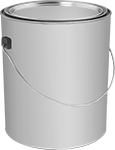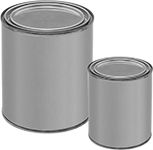About Paint and Protective Coatings
More
Static-Control Coatings for Concrete Floors

Commonly used by electronics manufacturers and research labs, apply these coatings to floors and walls to protect equipment from static electricity buildup. Repair cracks and holes prior to application. Apply with a brush, roller, or sprayer.
Dry Time | ||||||||||||
|---|---|---|---|---|---|---|---|---|---|---|---|---|
| Container Size, gal. | Composition | Touch, hrs. | Overall, hrs. | Approx. Coverage @ Thick. | Max. Temp., °F | Application Temp. Range, °F | Electrical Properties | Surface Resistivity | For Use On | Choose a Color (Appearance) | Each | |
| 1 | Water Based | 4 | 24 | 200 sq. ft. @ 15 mil | 240° | 55° to 100° | Conductive | 103-105 ohms/sq. | Steel, Ceramic, Masonry, Concrete, Wood | Black (Satin) | 000000 | 0000000 |
| 1 | Water Based | 4 | 24 | 200 sq. ft. @ 15 mil | 240° | 55° to 100° | Static Dissipative | 106-1011 ohms/sq. | Steel, Ceramic, Masonry, Concrete, Wood | 000000 | 000000 | |
EMI/RFI Shielding Coatings for Electronics

Protect sensitive electronic parts, enclosures, and prototypes from electromagnetic interference (EMI) and radio frequency interference (RFI) with these coatings. Also known as conductive paint, these coatings block EMI and RFI from disrupting electrical, data, and radio signals, which can cause circuit malfunctioning and data loss.
For best adhesion, apply to clean, oil-free surfaces. If applying to highly chemical-resistant plastics such as PVC and PTFE, use a primer first.
Carbon acrylic coatings are made with ground carbon powder mixed with acrylic. They're best for RFI and low-frequency shielding applications, such as protecting jumpers and resistors in initial prototypes, since they're not as conductive as nickel and silver acrylic coatings. They don’t contain metal, so they’re also great for electronics where metal-filled coatings could cause malfunction, such as metal detectors.
Nickel acrylic coatings are made with nickel flakes mixed with acrylic. They’re the best in our offering for protecting magnetic components, since they absorb and redirect magnetic fields. While not as conductive as silver acrylic coatings, they still protect against a broad spectrum of EMI and RFI frequencies. Use them to repair small circuits on circuit boards and to coat devices such as meter and scanner housings. They have good corrosion resistance.
Silver acrylic coatings are made with silver flakes mixed with acrylic. They’re the most conductive coatings in our offering, so they protect against the broadest spectrum of EMI and RFI frequencies. They’re also the most corrosion resistant. Use them to coat portable electronics, access panels, industrial cabinets, and engine control modules.
Coatings that cannot be sold to the listed areas are restricted by product labeling requirements.
Dry Time | Temp. Range, °F | ||||||||||||
|---|---|---|---|---|---|---|---|---|---|---|---|---|---|
| Container Net Weight, oz. | Consistency | Touch, min. | Overall, hrs. | Interference Reduction @ Frequency | Surface Resistivity, ohms/sq. | Min. | Max. | For Use On | For Use Outdoors | Color | Cannot Be Sold To | Each | |
Carbon Acrylic | |||||||||||||
| 12 | Thin Liquid | 5 | 24 | 10 dB @ 1 GHz | 100 | -40° | 245° | Plastic | Yes | Black | Canada | 000000000 | 000000 |
Nickel Acrylic | |||||||||||||
| 12 | Thin Liquid | 5 | 24 | 55 dB @ 1 GHz | 0.49 | -40° | 245° | Plastic | Yes | Gray | Canada | 000000000 | 00000 |
Silver Acrylic | |||||||||||||
| 12 | Thin Liquid | 30 | 24 | 70 dB @ 1 GHz | 0.10 | Not Rated | 185° | Plastic | No | Silver | __ | 00000000 | 000000 |
Heavy Duty EMI/RFI Shielding Coatings for Electronics

Coat electronics for durability in tough conditions while blocking EMI/RFI signals. Made of epoxy mixed with silver-coated copper, these coatings are stronger than acrylic EMI/RFI coatings. They are rigid enough to withstand the wear of access panels and industrial cabinets. You can also use them in engine compartments because they resist damage from high temperatures and chemicals. Also known as conductive paint, they shield your parts from interference that could cause circuit malfunction and data loss. Mix the two parts of these compounds together and paint them on components. These coatings cannot be sold to Canada due to product labeling requirements.
Dry Time | ||||||||||||
|---|---|---|---|---|---|---|---|---|---|---|---|---|
| Container Size, fl. oz. | Consistency | Touch, min. | Overall, hrs. | Interference Reduction @ Frequency | Surface Resistivity | Temperature Range, °F | Heating Requirements to Reach Full Strength | For Use On | Color | Cannot Be Sold To | Each | |
| 27 | Thin Liquid | 5 | 4 | 55 dB @ 1 GHz | 0.31 ohms/sq. | -40° to 245° | 4 hrs. @ 150° F | Aluminum, Steel, Stainless Steel, Ceramic, Glass, Plastic, Chrome, Galvanized Steel | Brown | Canada | 0000000 | 0000000 |
Static-Control Coatings

Protect sensitive electronic equipment from sparks, shorts, and sudden discharges. These acrylic-based coatings contain low-conductivity pigments to dissipate electric charge and prevent static buildup on your equipment. Reliable enough for use on semiconductors, they’re often used to shield tools, conveyors, work surfaces, and enclosures. Once cured, these coatings are flexible and durable. They also won’t crack, chip, or peel.
Product labeling requirements restrict sales to the listed areas.
Dry Time | ||||||||||
|---|---|---|---|---|---|---|---|---|---|---|
| Container Net Weight, oz. | Touch, min. | O'all, hrs. | Temp. Range, °F | Electrical Properties | Surface Resistivity, ohms/sq. | For Use On | Color | Cannot Be Sold To | Each | |
Acrylic | ||||||||||
| 12 | 5 | 24 | -40° to 245° | Static Dissipative | 1.2 × 107 | Plastic | Gray | Canada | 0000000 | 000000 |

























